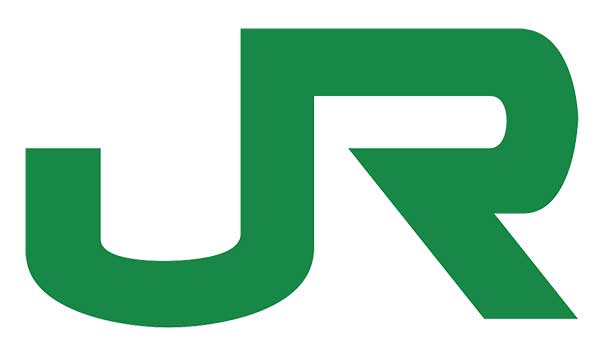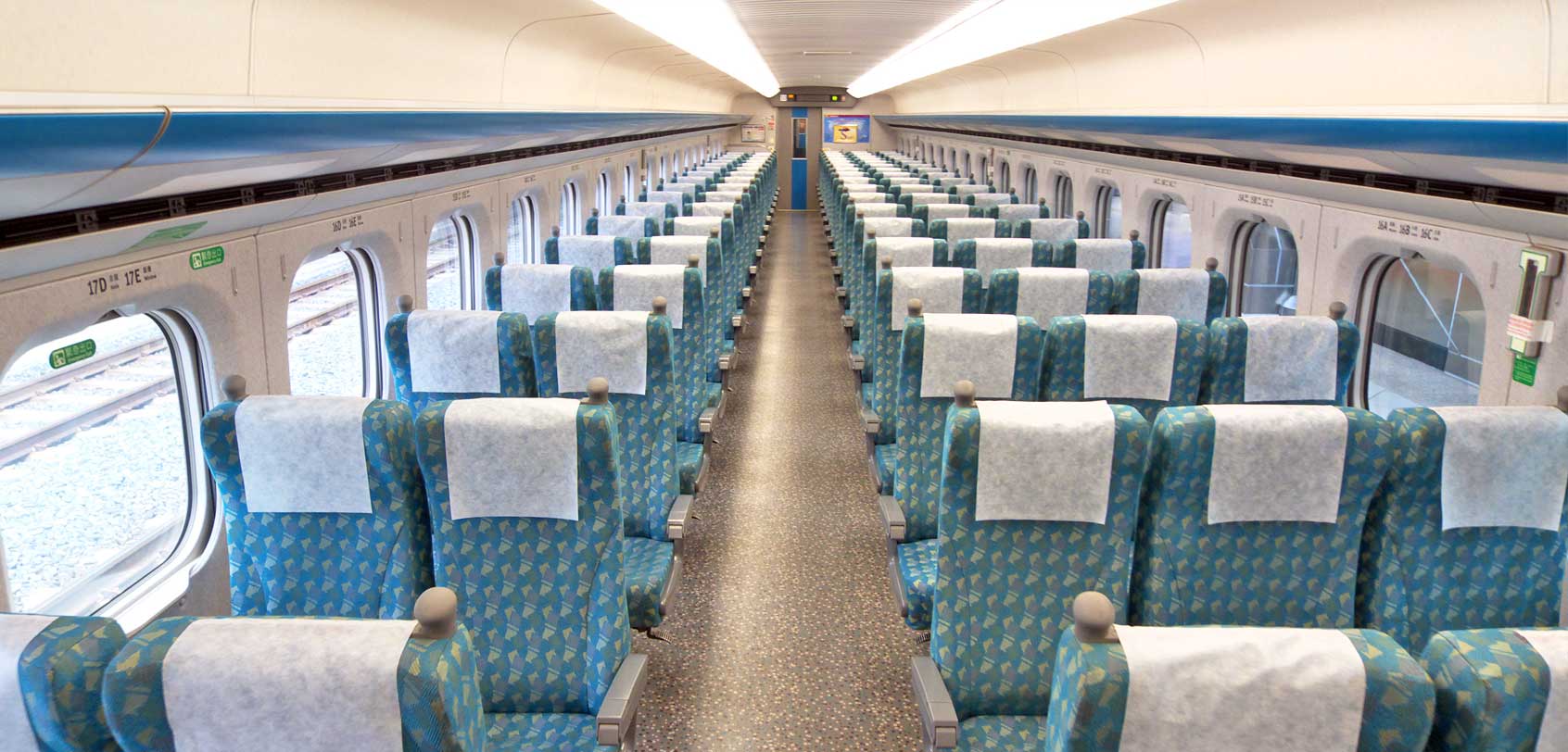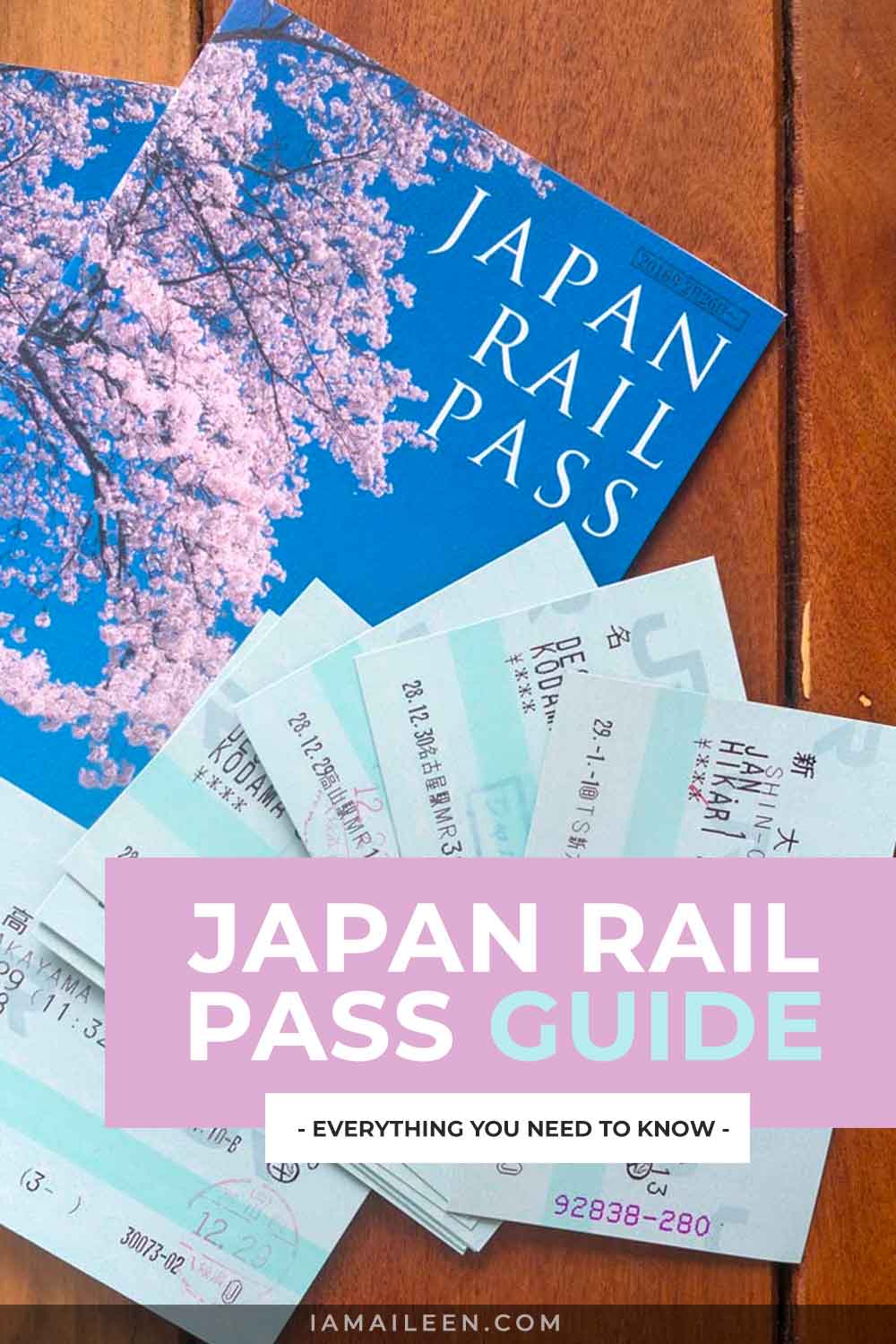If Europe has its own famous train pass called ‘Eurail Pass‘, then so does Japan and it is called the Japan Rail Pass (or JR Pass).
Now, of course, it’s no news that the country is a relatively expensive destination to go to — but fortunately for us, using a JR pass is one of the best options to take if we want to make the most of our travel budget.
First things first though, there are several things that you have to take note of before purchasing this JR pass and with the help of this guide, I hope that you will make a sound decision for it.
RELATED READ:
– Sample Japan Itineraries
– Tokyo Itinerary
About The Japan Rail Pass
» What is a Japan Rail Pass?
The Japan Rail (JR) Pass (link) is basically a special nation-wide train pass offered by the Japan Railways (JR) Group and it grants unlimited travel on its extensive rail network (including bullet trains or ‘shinkansen’), bus lines, and ferry routes that all go through the major areas of Japan.
That being said, “JR” is the keyword here; therefore, it means that the pass only applies to modes of transportation under the JR group. Hence, this does not include other major services like Nozomi, Mizuho, etc. Rest assured, JR is a huge rail service which is why a lot of visitors go for their train pass.
To date, the primary nationwide Japan Rail Pass has 3 duration options and 2 categories…
*The prices are as of January 2019. Take note that children who are 6 to 11 years old can enjoy a 50% discount on the prices stated above; whereas children 5 years and below can ride for FREE — however, they do not have a reserved seat, which then means that if all seats are full, the child needs to sit with an adult.
NOTE: A Japan Rail Pass must be used on consecutive days within its allotted duration. Also, its expiry is not based on a precise hour metric. So if you start using your 7-day JR Pass at 12PM on January 1, it will expire at midnight of January 7 — it will NOT expire at 12PM of January 8.
As for the class, I actually don’t find a huge difference between standard (second class) and first class (green) carriages in their shinkansen (bullet trains). After all, Japan has high-quality trains that have ample legroom, spacious seats, charging outlets, and luggage spaces that are properly maintained. With that said, the only perks I see in taking the green carriages are as follows:
- You’ll have 4 seats total in one row in a green carriage, compared to 5 or 6 on the standard trains.
- You get a bit more leg space in your seats (but in my opinion the standard trains are spacious enough).
- Few people often get green passes so you can enjoy a bit of a quieter time (then again, all trains are quiet in Japan due to the disciplined etiquette that’s practiced by the locals).
- Depending on the train, there would sometimes be electric reclining seats with reading lights.
Either way, I do see a disadvantage in getting a first-class (green) JR Pass and it’s when you need to reserve your seat in advance. I say this because all green car seats must be reserved beforehand. As such, if you are in a hurry, this can be a big hassle. Rest assured, if you hold only a standard Japan Rail Pass, you can either reserve your seats or just simply hop on an unreserved section of the train.
» What areas does Japan Rail Pass cover?
The Japan Rail Pass (stated above) covers the whole of Japan.
However, if you only want to explore specific regions in the country, JR has seven (7) other train pass categories which you can consider purchasing instead if you want to save up even further…
- JR Kansai Area Pass
Areas: Kyoto, Kobe, Osaka, Himeji, Nara, Kansai International Airport
Price: Starts at $20~ (1 day) up to $55~ (4 days) - JR Hokkaido Pass
Areas: Hokkaido including Sapporo
Price: Starts at $150~ (3 days) up to $210~ (7 days)- 3 Days
- 4 Days Flexible
- 5 Days
- 7 Days
- Combination: East + South Hokkaido 6 Days Flexible
- Combination: Tohoku + South Hokkaido 5 Days Flexible
.
- JR West: Sanyo San’in Area Pass
Areas: Kyoto, Osaka, Kansai Airport, Nara, Wakayama, Kobe, Himeji, Okayama, Kurashiki,
Takamatsu, Hiroshima, Miyajima, Tottori, Matsue, Hakata (Fukuoka)
Price: $165~ for 7 days - JR Central: Takayama Hokuriku Pass
Areas: Historic Hokuriku region, Shirakawa-go, Takayama, Kanazawa
Price: $120~ for 5 days - JR East
- Areas: Kanto, Koshinetsu (Yamanashi, Nagano, Niigata)
5 Days Flexible - Areas: Kanto, Tohoku
5 days Flexible
.
- Areas: Kanto, Koshinetsu (Yamanashi, Nagano, Niigata)
- All Kyushu Area Pass
Areas: Kyushu
Price: $130~ for 3 days or $155~ for 5 days - All Shikoku Pass
Areas: Shikoku
Price: Starts at $80~ for 3 days up to $110~ for 7 days
NOTE: These passes (except the Takayama Hokuriku Pass) can be purchased within Japan.
» Who is eligible to buy a Japan Rail Pass?
The Japan Rail Pass can only be used by non-Japanese nationals who enter Japan with a temporary tourist visa.
People who hold work visas, student visas, permanent residence visas, entertainer visas, trainee visas, and re-entry permits cannot use a Japan Rail Pass.
» Where to buy a JR Pass?
As I’ve mentioned previously, the JR Passes can be purchased online as well as in Japan or through travel agents worldwide. However, if you ask me it is best to book them online beforehand especially for the nationwide Japan Rail Pass.
I say this because purchasing the nationwide JR Pass in Japan’s major stations and airports come at a higher cost than the standard rates I previously mentioned. (As of 2019, it is said that this service is offered only until March 31, 2020 — but it’s possible that it can extend beyond that point).
So where online can you purchase your Japan Rail Passes at the cheapest cost?
- Book with Klook and you can have the passes delivered straight to your address — no matter where it is in the world.
- For the other regional passes, just click the links I stated in the previous section.
Take note that you can purchase a pass up to 90 days ahead of the date that you plan to use it. Once you receive it in the mail, there will be instructions as to how you can exchange the voucher for an official JR Pass in Japan’s JR station office. (I usually exchange mine at Narita Airport’s JR East Travel Service Center.)
» How to claim my JR Pass in Japan after purchasing it online or through travel agents?
Once you’re in Japan, you can exchange the voucher (which you’ll receive after purchasing the JR Pass online or via travel agents) at any designated JR train stations or major Japan airports. For a list of these locations and their operating hours, see here. (Just make sure to have your passport on hand when claiming your JR Pass).
» Is it worth it to buy a Japan Rail Pass?
It totally depends on your itinerary.
For example, if your itinerary includes an airport connection at Narita or Haneda with a Tokyo to Kyoto round-trip, then for sure, purchasing a 7-day Japan Rail Pass is totally worth it. After all, the total transportation cost for that route almost equals the 7-day pass’ price — as such, you can use this scenario as a ‘rule of thumb’.
The way I see it though, a Japan Rail Pass is a good purchase to make only if you plan to hop from one faraway city to the next in a short span of time. So if you’re planning to stay in cities for longer periods each, it’s best to either purchase single tickets or regional passes. Yet once again, it really depends so it’s best to calculate this all by hand if you really want to lessen your costs.
For starters, you can list down all your planned transits and then check the train ticket prices through websites like Google Maps, Rome2Rio and Hyperdia (besides, sometimes there are train lines other than JR that are not only faster but also cheaper). Another great tool that you can use is this Japan Guide Calculator for seeing approximate train ticket costs on JR lines.
NOTE: Some other tips to take note of…
— It’s often ideal to group expensive and longer distance trips during the duration of your JR pass, and then just buy individual tickets outside of that period. (Example: Individual train tickets in Tokyo and then use JR Pass for Kyoto + Osaka + etc. trips.)
.
— If you’re only traveling around Tokyo, it’s better to just purchase prepaid IC cards that are called Suica and Pasmo. They can be used both for trains and buses and they basically offer you convenience so that you don’t need to get a ticket every time you ride.
» How to know if it’s a JR train?
Just enter the station gates that have the JR logo (some just have the word JR). Nevertheless, if you are ever unsure, you can just show your Japan Rail Pass to any station staff and they will gladly assist you. I’ve actually noticed that with the coming of Tokyo 2020, more and more people are speaking English. Signages are also improving so that’s a huge plus.
Once you are at a JR station gate, you only need to show your pass to the guard box in order to get in. So unlike the others, you do not have to tap anything on the entry terminals.
» How are the Japan trains like?
In all my travels, I like Japanese trains the most because they are not only clean but also comfortable and modern. Not to mention that the people are disciplined (except for rush hours because you can sometimes expect some pushing haha), the arrival + departure times are so accurate, and so much more!
As for the bullet trains (shinkansen), they are my favorite because they feel like a first-class airplane ride on land — and yes, they can travel as fast as 320 km/h! Take note though that the fastest shinkansen is on the Nozomi line; therefore, it’s not covered by the Japan Rail Pass. However, this is not to say that JR’s shinkansen are slow, of course not; besides, JR has the Hikari shinkansen which is almost as fast as Nozomi.
On the other hand, aside from the bullet train lines, the regular trains are usually of these types:
- Local: I usually avoid this because it will stop at every single station of the line it is on, so unless you are just one or three stations away, don’t ride this one.
- Rapid: Almost similar to local trains but they at least skip some stations.
- Express: Skips more stations than the rapid trains.
- Limited Express: These only stop at the major stations so they’re best if your station stop is far away from where you are.
» Can I reserve train seats in advance?
Seat reservations are usually done for bullet trains (shinkansen) and yes, you can reserve seats for an unlimited number of times with your Japan Rail Pass. (Remember that if you hold a first class Japan Rail Pass, you always need to reserve your seat before riding a bullet train).
In order to do this, you need to go to a JR office in the JR stations; otherwise, you can reserve your seats beforehand during the time that you exchange your JR Pass for the first time.
NOTE: If you hold a standard (2nd class) Japan Rail Pass, you do NOT necessarily need to reserve seats in a shinkansen because you can just enter a carriage for unreserved seats — this is typically ideal if you are in a rush! However, if you are traveling during peak hours or peak season, it is better to reserve your seats in advance.
» Is it difficult to find and ride the Japan trains?
Tokyo, for instance, has such a dense railway system so I can understand that it can be very overwhelming — but don’t worry! Aside from the fact that the train staff is helpful and plenty, there are various apps and websites that you can use to make your travel time fast and hassle-free.
For this, a lot of people use Hyperdia (don’t forget to filter the results to JR trains if you need it so) but I personally like to use Google Maps more.
Besides, Google Maps includes real-time walking navigation so I’m never lost in Japan! If there ever is a time that there are no English translations, I can also take a photo of the sign and translate it with the Google Translate app. (Yup, we’re so lucky to be living with this kind of technology now!)
» BONUS: Japan Train Etiquette
- Follow the queue and lines when waiting for the train. There are marked areas on the platform after all, so take note of that.
. - When the train arrives, wait until all exiting passengers are out of the train before you board.
. - There are racks near the door and above the seats in bullet trains where you can store your luggage. The racks by the door even have locks so you can have some peace of mind when leaving your larger items.
. - Try to keep noise down to a minimum and put your phone on silent. You will notice this yourself that locals in Japan try to be as silent and proper as possible when they are riding the train because they find it rather impolite if people talk too loudly or make too much noise.
- I still fondly remember riding a rural train and it was SO quiet that I felt incredibly uneasy when I was trying to crumple the plastic trash that I had into my bag. Given that everything was extremely quiet, the sound I was making made me feel so rude that I just let the plastic as is in my bag, haha!
.
- I still fondly remember riding a rural train and it was SO quiet that I felt incredibly uneasy when I was trying to crumple the plastic trash that I had into my bag. Given that everything was extremely quiet, the sound I was making made me feel so rude that I just let the plastic as is in my bag, haha!
- Bullet trains have regular attendants who check the tickets of the passengers so if you reserved a seat, make sure that you are in the correct place.
- It’s fine to move to spare seats if you want a better view BUT you must leave that seat before the next station since there could be another person coming in who has that seat reserved. Better yet, try not to change seats at all because a train attendant could also be passing by at that moment.
.
- It’s fine to move to spare seats if you want a better view BUT you must leave that seat before the next station since there could be another person coming in who has that seat reserved. Better yet, try not to change seats at all because a train attendant could also be passing by at that moment.
- On local trains or subways, refrain from eating and drinking anything other than water. Truth be told, the Japanese don’t usually eat in the trains nor do they eat while walking in public. However, riding the bullet trains is a different matter because you can bring food in there and drink anything that you want. In fact, there will be trolleys selling food and drinks that will regularly make rounds in the train.
- As courtesy, try not to bring in smelly food and always clean up before you leave.
- If you ever lose any stuff in the bullet train, you can often expect that item to be in the train’s Lost & Found office
- Case in point, I just got off a station and realized that I left my bag on the top rack. In just 10 minutes, the staff had my bag on hand with nothing missing! (TRIVIA: There are cleaners or train staff members in every station who go swiftly through the bullet train carriages to clean, this is why they were able to grab a hold of my stuff instantly!)
• • •
Overall
I hope that this ultimate guide helped you understand the Japan Rail Pass better! Let me know how your experience goes.







Hi! Thanks for the guidance for first time travelers to Japan. My question is “Do we need to purchase JR tickets??” since our 7-day OSAKA trip we will be staying most of the time in OSAKA only. A short trip to Universal Studios and Kyoto perhaps?
If that’s the case, then no, you don’t need to purchase JR tickets. For Osaka, you have various options. For instance, here are some of your options:
– Osaka Pass for unlimited travel in Osaka
– Osaka Amazing Pass for unlimited travel in Osaka (including free entrance to some top attractions)
– ICOCA IC Card if you just want a reloadable transportation card (much like a Beep card we have in the Philippines)
– Kansai Thru Pass for unlimited travel around Osaka, Kyoto, Nara, and Kobe
Hope this helps!
Hi Aileen thanks for providing us a very detailed japan itineraries. We are planning to spend the first 4 days around Tokyo (Westside Tokyo, Eastside Tokyo, Disneyland and Mt. Fuji), can you please recommend on how can we save money for train transportation? Should we buy JR pass or purchase Suica card? TIA
Hey Glenn, glad to hear that this helps :D Also, if you’re only going to travel within Tokyo, a Suica or Pasmo card is enough. The JR Pass is mostly better if you’re planning to go out of Tokyo too.
Hi Aileen,
We are a resident of New Zealand but still, we are using a Philippines passport. Do we still need to apply for a visa to go to Japan? Thank you.
Yes, since you still hold a Philippines passport, you need to apply for a visa to Japan in the embassy in New Zealand.
Hi Aileen,
Thank you so much for this very comprehensive information about the JR trains. You have been one of my most treasured traveler-writer since my husband and I have made our way around (hopefully, by God’s grace for a longer time still) and your well-researched info and own experiences have made ours more memorable and safe (from getting lost or turning a wrong corner — haha). If I may just add a little update from my own, as I am preparing our IT( for my family’s guide only) for Japan again, we have availed of the JR Kansai Hiroshima Pass and I read that the Nozomi and Mizuho shinkansen trains are added options to the ride already — so, i immediately plotted these two in our adventures — isn’t that awesome! I pray that the Lord will always keep you safe in your travels and will never tire to share your own adventures where many people are blessed. Thank you, Aileen, and I hope to meet you somewhere out there someday, somehow :) —- (Tita) April
Hey Tita April! ;)
I ‘m very happy to hear from you! It brings me joy to know that my guides are of help to you. Wishing you all the best on your trip and let me know how it goes. Enjoy your vacation!
Hi Aileen!
My friends and I bought plane tickets to osaka, japan on October 2019 and we are planning to visit Osaka, Kyoto and Nara for 5 days. Do you think we need to buy a JR pass in our travel to the said cities? Is is advisable to purchase that pass?
Thanks!
Most likely you won’t if it’s just those places. But to be sure, use the calculator I mentioned above to see an estimate and compare it to a JR pass. :) Hope that helps.